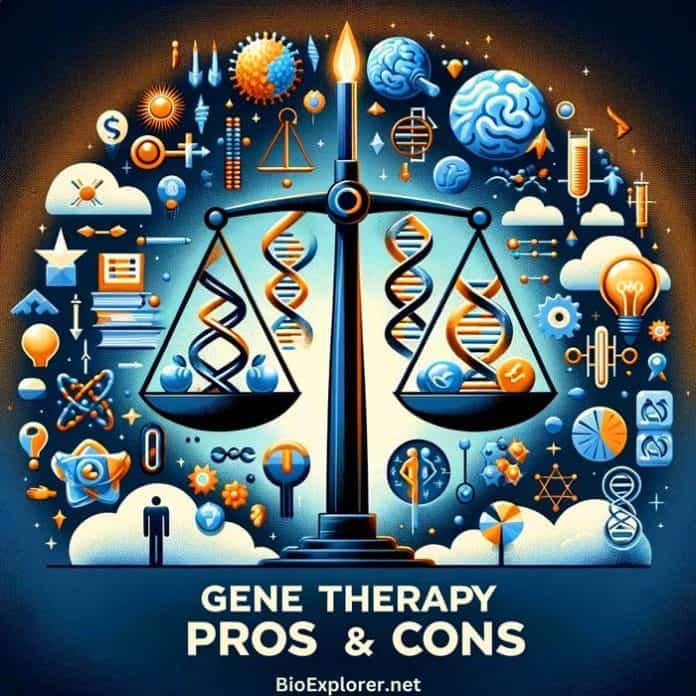
Gene Therapy Pros and Cons: Gene therapy is involved in the replacement of a defective gene within a cell’s nucleus with the genetically healthy and functional gene. It is also known as ‘Gene Augmentation‘. Genes are basically nitrogenous based codes that encode secret information of all of the amino acid formation in the body.
Table of Contents
- Types of Gene Therapy
- Top 10 Pros of Gene Therapy
- 1. Genetic Disorders Are Treatable
- 2. New Field of Medicine
- 3. Beacon of Light
- 4. Diversified Options
- 5. Equal Applications in Non-Humans
- 6. Basis of New Potential Discoveries
- 7. Technology-based Therapy
- 8. Increases Lifespan
- 9. Enhances Overall Health
- 10. Offers Large-Scale Treatment
- 11. Precision Medicine
- 12. One-Time Treatments
- 13. Potential Cost Savings
- 14. Ethical and Social Benefits
- 15. Innovation and Economic Growth
- 16. Global Health Impact
- Cons of Gene Therapy
- 1. Serious Ethical Concerns
- 2. Religious Concerns
- 3. Ineffective Approach to Medical Science
- 4. Might Not Be Long-Term Effective
- 5. Expensive Option
- 6. Currently Unreliable Delivery Method
- 7. Uninsured Results
- 8. May Encourage Gene Doping
- 9. Can Provide Unintended Side-Effects
- 10. Invasion of Privacy
- 11. Limited Accessibility
- 12. Regulatory Hurdles
- 13. Technical Challenges
- 14. Psychological Impact
- 15. Environmental Concerns
- 16. Insurance Coverage and Cost-effectiveness
- 17. Dependency on Technological Advancements
- 18. Technical and Ethical Barriers
Types of Gene Therapy
In a simpler terms, there are 2 types of Gene therapy namely:
A) Somatic Gene Therapy: This type of gene therapy involves the transferring of a section of DNA to a somatic cell (example: bone cells) to another. The effects of somatic gene therapy will not pass onto the patient’s offspring.
B) Germline Gene Therapy: In this type of gene therapy, a section of DNA of an egg or sperm cell is transferred to another reproductive cell. The effects of germline gene therapy will transfer onto the patient’s children and following generations.
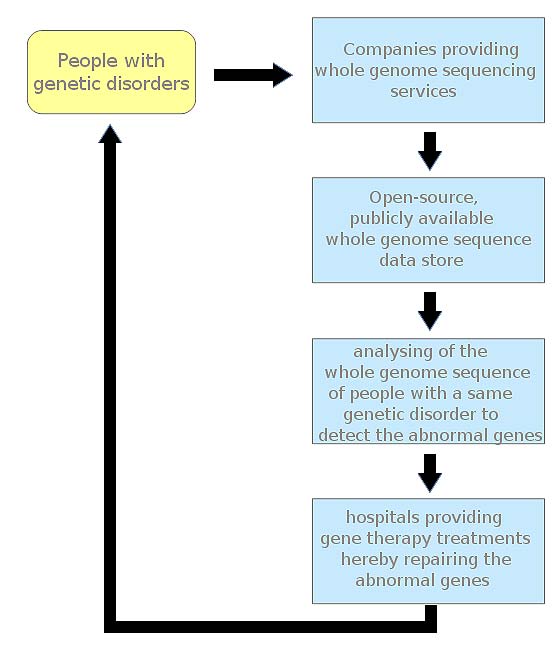

As protein’s building blocks are amino acid and a single change in any single information regarding amino acid synthesis will yield disastrous results so; genes are crucially important in normal body functioning.
Diseases in which genes are involved have long been dreaded as they till now they have been severe and incurable. These disorders can only be managed with the help of significant changes in lifestyle and with some aid from medications. But now gene therapy has somehow alleviated the hazards of these disorders.
Gene therapy certainly likes so many others has both positive as well as negative aspects. Some of them are listed below:
Top 10 Pros of Gene Therapy
Here are the pros or advantages of gene augmentation therapy:
1. Genetic Disorders Are Treatable
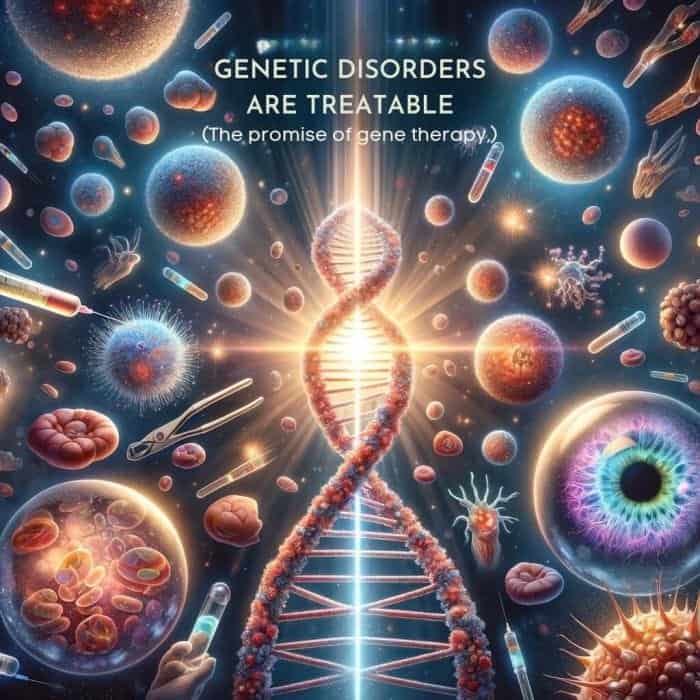
Gene Therapy presents a groundbreaking approach to treating Genetic disorders by directly addressing their root cause: the genetic abnormalities themselves.
- Unlike traditional treatments that manage symptoms without curing the underlying condition, gene therapy aims to rectify or compensate for the defective genes, potentially offering a one-time, lasting solution.
- This method involves introducing, removing, or altering genetic material within a patient’s cells, enabling the treatment of a wide range of genetic disorders, from single-gene conditions like cystic fibrosis and sickle cell disease to complex diseases such as cancer.
Scientific Anecdotes for References:
- A pivotal study in gene therapy is the treatment of adenosine deaminase deficiencyWhat is adenosine deaminase deficiency?Adenosine deaminase deficiency is a rare genetic disorder causing severe immune dysfunction by preventing the breakdown of certain toxins that damage immune cells. This leads to life-threatening infections, requiring treatments like enzyme replacement, gene therapy, or stem cell transplantation to manage. (ADA-SCID). This rare genetic disorder compromises the immune system. Gene therapy for ADA-SCID involves using a viral vector to introduce a functional copy of the ADA gene into the patient’s cells. Clinical trials have demonstrated that this approach can restore immune function in affected individuals, allowing them to lead healthier lives. This success story highlights the therapeutic potential of gene therapy for genetic disorders. It serves as a beacon for the treatment of other genetic conditions.
- Another noteworthy example is the use of gene therapy for treating Leber’s congenital amaurosisWhat is Leber's congenital amaurosis?Leber's congenital amaurosis is a genetic eye disorder that leads to severe vision loss or blindness at birth or within the first few months of life. It results from mutations affecting the retina, impairing its ability to detect light and send visual signals to the brain. (LCA), a genetic disorder leading to severe vision loss at an early age. Gene therapy has restored vision in individuals with this condition by directly delivering a normal copy of the RPE65 gene into the retina. The FDA-approved treatment, voretigene neparvovecWhat is voretigene neparvovec?Voretigene neparvovec is a gene therapy drug designed to treat Leber's congenital amaurosis and other retinal dystrophies caused by mutations in the RPE65 gene. It works by delivering a normal copy of the RPE65 gene directly into retinal cells, restoring their ability to produce the protein necessary for normal vision. (Luxturna), marks a significant milestone in the field, demonstrating the feasibility and impact of gene therapy on improving the quality of life for patients with genetic disorders.
2. New Field of Medicine
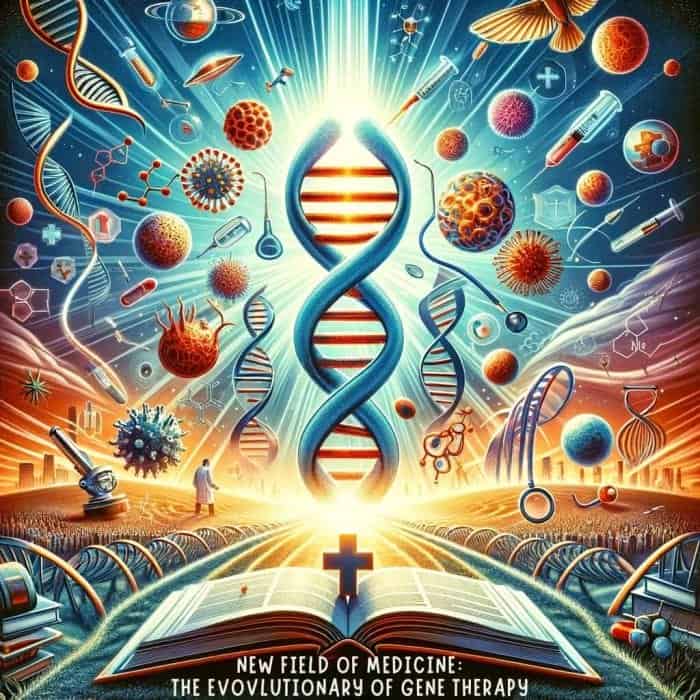
Gene therapy represents a revolutionary shift in the field of medicine, offering a new paradigm for treating diseases at their genetic root.
- This innovative approach allows for the direct treatment of genetic disorders, potentially curing previously considered untreatable diseases.
- By introducing, removing, or modifying genes within an individual’s cells, gene therapy aims to correct the underlying genetic causes of disease, offering hope for definitive treatments for a wide array of genetic conditions, including inherited diseases, some types of cancer, and certain viral infections.
Scientific Anecdotes for References:
- Gene therapy’s journey from a theoretical concept to a practical medical application underscores its potential to change the landscape of disease treatment. Developing safe and efficient gene delivery systems, such as viral vectors, has been pivotal. Recent clinical successes in gene therapy, such as treating hemophiliaWhat is hemophilia?Hemophilia is a genetic disorder that impairs the body's ability to make blood clots, a process needed to stop bleeding. This leads to excessive bleeding following injury or surgery and can cause spontaneous bleeding into joints and muscles, potentially resulting in pain and long-term damage., certain types of blindness, and spinal muscular atrophy, highlight the field’s potential to provide durable, life-altering treatments. These successes underscore gene therapy’s emergence as a central player in the new era of personalized medicine.
- The rapidly evolving state of gene therapy is further evidenced by the approval of novel therapies that target genetic diseases at their source. The FDA’s approval of treatments like Luxturna for Leber congenital amaurosis and ZolgensmaWhat is Zolgensma?Zolgensma is a gene therapy medication approved for the treatment of spinal muscular atrophy (SMA) in pediatric patients. It delivers a functional copy of the human SMN gene to target cells via a viral vector, aiming to provide a one-time, lifelong treatment for this genetic disease by producing the SMN protein essential for muscle movement and strength. for spinal muscular atrophy exemplifies the progress in this field. These advancements are built on decades of research and development in vector technology, Gene EditingWhat is Gene Editing?CRISPR, which stands for Clustered Regularly Interspaced Short Palindromic Repeats, is a cutting-edge genetic editing tool enabling precise alterations to DNA in living organisms., and our understanding of genetic diseases. The evolution of gene therapy from experimental trials to approved treatments marks a significant milestone in its clinical application, demonstrating its potential to address unmet medical needs across a broad spectrum of diseases.
3. Beacon of Light

Gene therapy serves as a beacon of light for patients with diseases previously deemed untreatable, offering new hope for cures and significant improvements in quality of life.
- This transformative approach in medicine targets the genetic basis of diseases, providing personalized treatments that can potentially cure conditions by correcting the underlying genetic defects.
- Gene therapy’s potential to offer definitive treatments is unparalleled, from rare genetic disorders to more common diseases like certain cancers. Its development is a testament to the power of scientific innovation to tackle some of the most challenging medical issues.
Scientific Anecdotes for References:
- Gene therapy’s revival as a central therapeutic strategy is underscored by its remarkable clinical benefits and safety records in recent trials. These trials have demonstrated gene therapy’s potential to cure or significantly ameliorate conditions once considered terminal or severely disabling. Advances in vector design and gene editing technologies, along with the engagement of Stem Cells for tissue regeneration and the harnessing of immune responses to combat cancer, have played pivotal roles in these achievements. This progress highlights gene therapy as a critical development in the quest to cure genetic diseases, offering hope where there was previously little or none.
- The clinical development of gene therapy has brought about significant successes across various diseases, including genetic disorders, neurodegenerative diseases, and cancers. These successes include the restoration of vision in patients with congenital blindness, the eradication of previously untreatable blood cancers, and the correction of hemoglobinopathies and coagulation deficiencies. Such outcomes are built upon decades of research that have led to safer, more efficient gene delivery methods. These developments represent a monumental stride in gene therapy and serve as a beacon of hope for patients suffering from various genetic conditions, demonstrating the transformative potential of gene therapy to provide lasting and meaningful clinical benefits.
4. Diversified Options
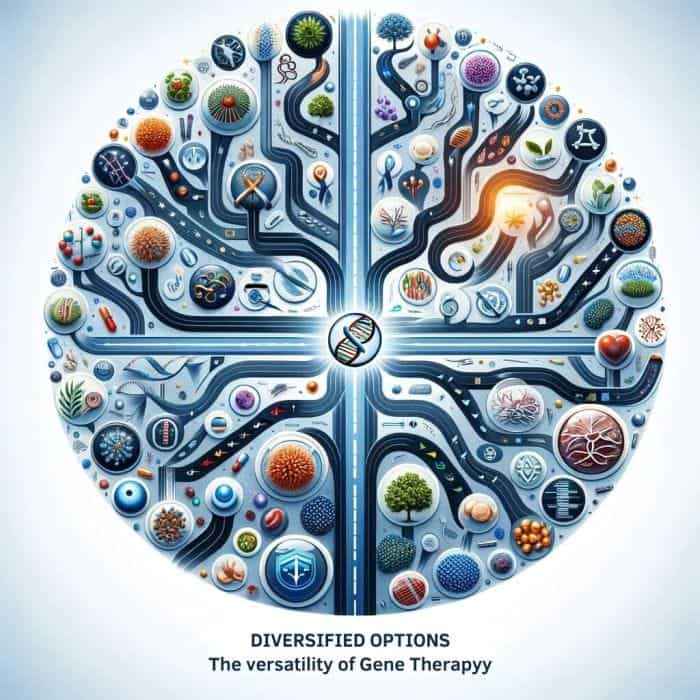
Gene therapy offers diverse treatment options that transcend traditional medical approaches.
- Targeting the genetic basis of diseases opens up possibilities for personalized medicine, providing treatments tailored to the individual genetic makeup of patients.
- This approach has broadened the scope of therapeutic interventions beyond what conventional treatments could offer, paving the way for innovative solutions to complex diseases.
- From targeting specific gene Mutations in cancer to correcting genetic defects responsible for inherited diseases, gene therapy’s versatility is its strength, enabling it to address a wide range of conditions with precision and effectiveness.
Scientific Anecdotes for References:
- The versatility of gene therapy is highlighted by its application across a spectrum of diseases, including cancer, genetic disorders, and neurodegenerative diseases. This approach leverages advanced vector designs for the safe delivery of therapeutic genes, gene editing to correct inherited mutations, and the engagement of stem cells for tissue regeneration. These advancements have led to remarkable therapeutic benefits and safety records in recent clinical trials, demonstrating gene therapy’s potential to deliver ‘cures’ for conditions previously deemed terminal or severely disabling.
- Gene therapy’s application in oncology exemplifies its diversified treatment options, offering strategies like replacing defective genes with functional ones, therapeutic gene activation or silencing, and using viral or non-viral vectors for targeted delivery. These strategies have been employed in various cancer treatments, demonstrating the potential of gene therapy to surpass conventional therapies in selectivity and efficacy, aiming to make cancer a controllable disease.
5. Equal Applications in Non-Humans
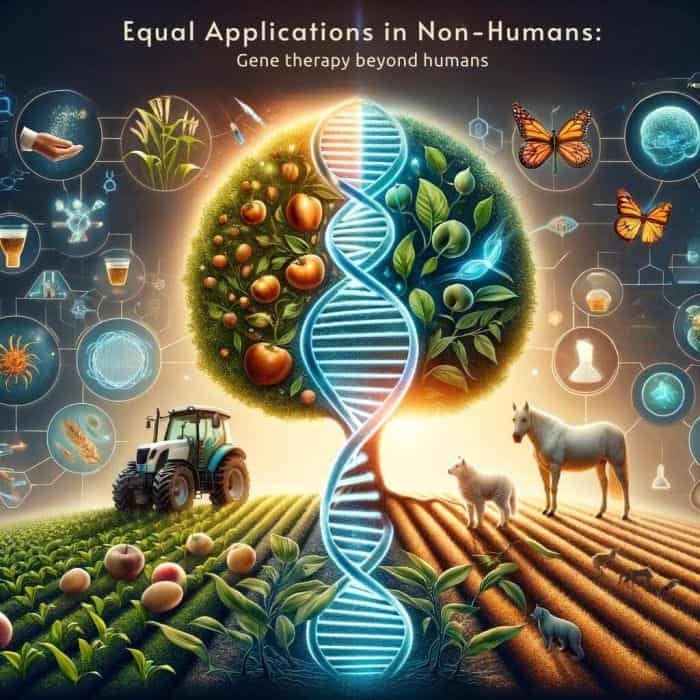
Gene therapy transcends the boundaries of human medicine, extending its revolutionary applications to Plants and Animals.
- This approach provides a foundation for enhancing the Lifespan, stabilizing health, and correcting genetic conditions across various species.
- In agriculture, gene therapy techniques are employed to fortify the natural immune systems of Crops against pathogens, pests, and environmental stresses, thereby improving yield, nutritional value, and resistance to diseases.
- Similarly, in veterinary medicine, gene therapy offers promising treatments for inherited disorders in domestic animals, contributing to their health and longevity.
- By modifying the genetic makeup to bolster defense mechanisms, gene therapy can potentially prevent the Extinction or endangerment of vulnerable species, ensuring Biodiversity and food security.
Scientific Anecdotes for References:
- The application of gene therapy in agriculture has led to significant advancements in crop improvement. Techniques such as CRISPR/Cas9 have been utilized to edit the genomes of various crops, enhancing their resistance to diseases, pests, and abiotic stresses. This improves crop resilience and productivity and reduces dependence on chemical pesticides, contributing to sustainable agriculture practices.
- In veterinary medicine, gene therapy has been explored to treat genetic disorders in animals such as dogs, cats, and livestock. For instance, studies have shown promising results in treating conditions like muscular dystrophy in dogs by introducing therapeutic genes that correct the underlying genetic defects. This improves the quality of life for affected animals and offers insights into human applications of gene therapy.
6. Basis of New Potential Discoveries

Gene therapy is not merely a treatment modality but a foundation for groundbreaking discoveries in medicine and biology.
- By manipulating the genetic code that dictates biological functions, gene therapy has unlocked new possibilities for understanding diseases at their core and developing treatments previously thought impossible.
- This evolving field has catalyzed advancements in vector technology, gene editing, and cellular therapy, offering hope for diseases without a cure and providing a platform for scientific exploration that could reshape our approach to medicine.
Scientific Anecdotes for References:
- The development and refinement of vector technologies have been pivotal in advancing gene therapy from theoretical potential to clinical application. Improved vector designs have enabled the precise delivery of therapeutic genes to target cells, minimizing risks and enhancing therapeutic efficacy. This progress has laid the groundwork for treating various genetic disorders, cancers, and infectious diseases, illustrating gene therapy’s role as a cornerstone for new medical breakthroughs.
- Gene editing technologies, particularly CRISPR/Cas9, have emerged as powerful tools for gene therapy, enabling the correction of genetic mutations at their source. This approach has significant implications for treating hereditary diseases, offering the potential for permanent cures. The application of gene editing in clinical settings marks a significant milestone in gene therapy, paving the way for personalized medicine and treating complex diseases at the genetic level.
7. Technology-based Therapy
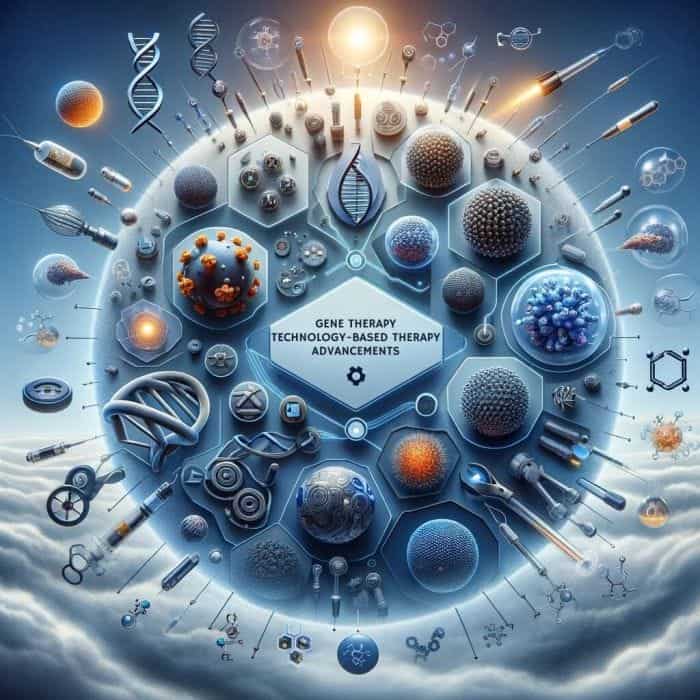
Gene therapy represents the epitome of technology-based therapy, leveraging cutting-edge scientific advances to treat diseases at their genetic roots.
- This innovative approach utilizes various technologies such as viral and non-viral vectors, CRISPR/Cas9 gene editing, and nanoparticle delivery systems to introduce, remove, or modify genes within a patient’s cells.
- These technologies have transformed gene therapy from a conceptual framework into a therapeutic reality, offering precise and tailored treatments for various genetic disorders, cancers, and viral infections.
- The Evolution of gene therapy technologies continues to address challenges related to delivery efficiency, target specificity, and safety, paving the way for broader clinical applications and more durable therapeutic outcomes.
Scientific Anecdotes for References:
- Non-viral vectors have emerged as promising delivery systems for gene-based therapy, overcoming some of the limitations associated with viral vectors, such as immunogenicity and potential insertional mutagenesis. Advances in material sciences, nanotechnology, and nucleic acid chemistry have led to the development of efficient and safe non-viral delivery systems, which are now being tested in clinical trials. These systems highlight the progress in gene therapy using non-viral approaches, offering a versatile platform for gene delivery with the potential for customizable and controlled gene expression.
- The advent of genome-editing technologies, particularly CRISPR/Cas9, has revolutionized gene therapy by enabling precise manipulation of the genome to correct disease-causing mutations, add therapeutic genes, or remove harmful sequences. This technology offers a powerful tool for gene and cell therapy, extending the therapeutic potential of gene therapy to a wider range of diseases, including those with complex genetic backgrounds. The ongoing development and application of genome editing in clinical settings underscore its significance as a transformative technology for future gene and cell therapies.
8. Increases Lifespan
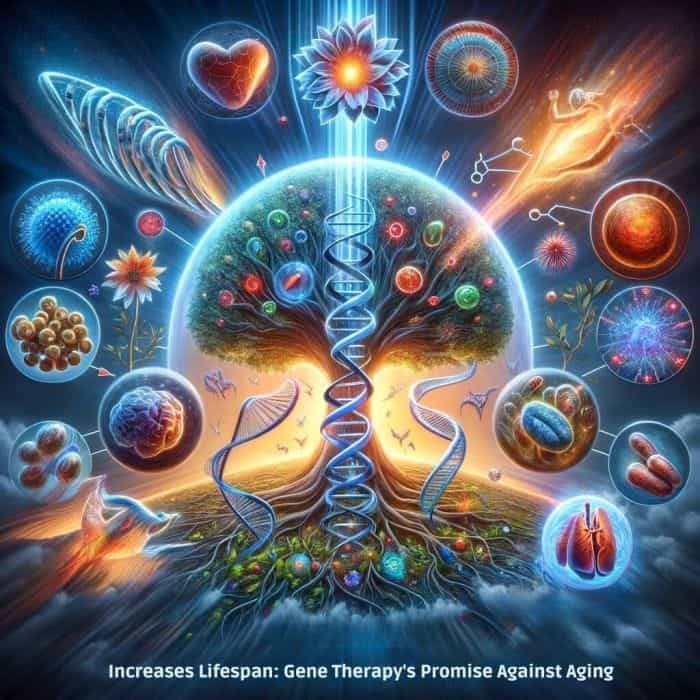
Gene therapy holds the potential to significantly increase Lifespan by targeting and modifying specific genes associated with aging and age-related diseases.
- This innovative approach has been explored in various animal models, demonstrating that interventions at the genetic level can delay aging processes, enhance health span, and extend Lifespan.
- Key mechanisms include enhancing telomerase activity, improving Mitochondrial function, reducing oxidative stress, and activating longevity-associated pathways.
- These findings suggest that gene therapy could one day be applied to humans to extend a healthy Lifespan and combat the detrimental effects of aging.
Scientific Anecdotes for References:
- Telomerase Gene Therapy in Mice: A study showed that telomerase gene therapy in adult and old mice could delay aging and increase longevity without increasing cancer risk. This therapy involved an adeno-associated virus expressing the mouse TERTWhat is TERT?Tooltip Content gene, which improved health markers, including insulin sensitivity and neuromuscular coordination, and extended median Lifespan by 24% and 13% in 1-year and 2-year-old mice, respectively. This landmark study demonstrates the potential of gene therapy to extend Lifespan in mammals without adverse effects on cancer risk, suggesting a promising avenue for anti-aging interventions.
- Genetic and Epigenetic Factors in Aging and Longevity: Research into the genetics and epigenetics of aging has identified numerous genes and pathways that contribute to lifespan extension. These include genes involved in DNA repair, stress response, metabolism, and epigenetic modifications that regulate gene expression. Understanding these factors offers insights into the molecular mechanisms of aging and identifies targets for gene therapy to promote longevity. This comprehensive review discusses the roles of genetic and epigenetic mechanisms in lifespan regulation, highlighting the potential for gene therapy to intervene in these processes and extend Lifespan.
9. Enhances Overall Health
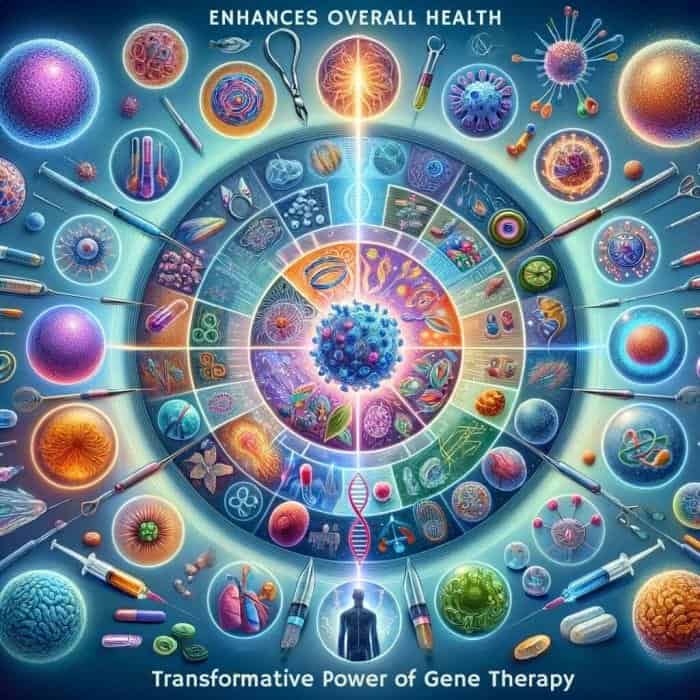
Gene therapy is a transformative approach to treating and potentially curing a broad spectrum of diseases by directly addressing the genetic causes.
- This innovative treatment modality can significantly enhance overall health by correcting genetic disorders, combating various forms of cancer, addressing neurodegenerative diseases, and treating immunodeficiencies.
- By repairing, reprogramming, or replacing faulty genes, gene therapy can restore normal function to cells and tissues, substantially improving health outcomes.
- This method holds promise for treating symptoms and targeting diseases at their source, offering the potential for durable and potentially curative treatments.
Scientific Anecdotes for References:
- Gene Therapy’s Broad Impact: Recent clinical trials have highlighted gene therapy’s capacity to deliver significant therapeutic benefits across a range of conditions, from genetic disorders to cancer. Improved vector designs and gene-editing technologies have played a crucial role in these successes, enabling precise and safe delivery of therapeutic genes. These advances are paving the way for gene therapy to become a cornerstone of treatment for diseases that were previously untreatable, underscoring its potential to enhance overall health significantly.
- Gene Therapy for Neurodegenerative Diseases: Gene therapy offers a powerful tool for treating neurodegenerative diseases, such as ALSWhat is ALS?Amyotrophic lateral sclerosis (ALS), also known as Lou Gehrig's disease, is a progressive neurodegenerative disease that affects nerve cells in the brain and the spinal cord. It leads to the loss of muscle control due to the death of motor neurons, eventually causing paralysis and death., spinal muscular atrophy, Parkinson’s disease, and Alzheimer’s disease. By focusing on vector design, delivery methods, and therapeutic targets, researchers aim to improve outcomes for patients with these challenging conditions. These efforts underscore gene therapy’s role in enhancing health by potentially halting or reversing the progression of neurodegenerative diseases.
10. Offers Large-Scale Treatment
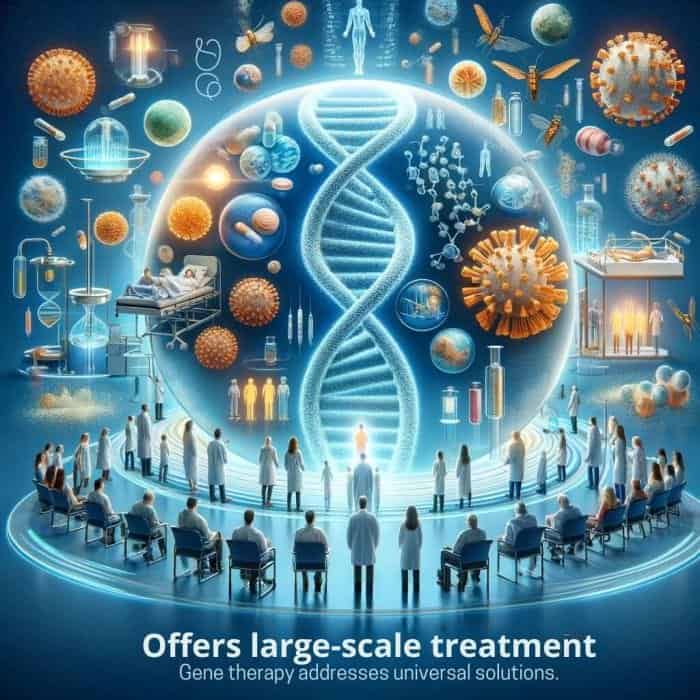
Gene therapy’s potential to offer large-scale treatment options is one of its most compelling prospects.
- Traditional treatments often target symptoms rather than underlying causes. They may not be effective for all patients due to genetic variability.
- Gene therapy, by contrast, can be designed to address the genetic root of diseases, offering the possibility of more universal and effective treatments.
- Moreover, advancements in gene editing technologies, such as CRISPR/Cas9, have made developing gene therapies easier and more cost-effective, increasing the potential for widespread application.
- As gene therapy techniques become more refined and accessible, they promise to provide large-scale solutions for diseases that were previously difficult to manage or incurable, including genetic disorders, certain cancers, and viral infections.
Scientific Anecdotes for References:
- Gene Therapy’s Clinical Successes: The transition of gene therapy from experimental stages to clinical reality underscores its potential for large-scale treatment. Recent clinical trials have demonstrated significant therapeutic benefits across various diseases, including genetic disorders and cancer, with improved safety profiles and efficacy. These successes highlight the maturation of gene therapy as a field and its potential to offer treatment options for a broad spectrum of conditions, moving towards large-scale application.
- Advancements in Gene Delivery Systems: Developing safe and efficient gene delivery vehicles, including viral and non-viral vectors, has been crucial in advancing gene therapy. Innovations in vector design and delivery mechanisms have increased the precision and reduced the risks associated with gene therapy, making it a more viable option for widespread treatment. These advancements in delivery systems are essential for the scalability of gene therapies, enabling their application across a wider range of diseases and potentially benefiting many patients.
11. Precision Medicine
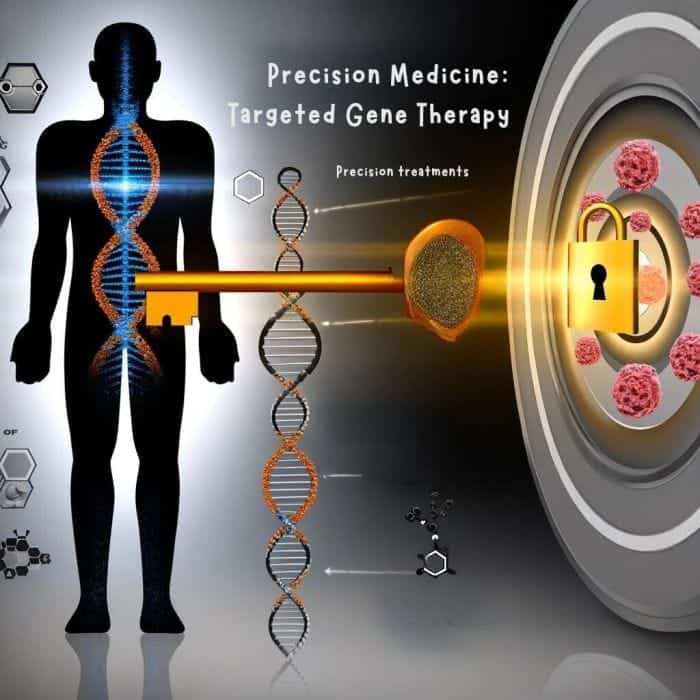
Precision medicine embodies the application of gene therapy to deliver treatments tailored to the unique genetic makeup of an individual.
- It represents a shift from the one-size-fits-all approach of traditional medicine to more targeted interventions that consider an individual’s genetic profile, environment, and lifestyle.
- In gene therapy, precision medicine allows for the design of therapies that directly target the genetic underpinnings of diseases, offering the potential for more effective and less toxic treatments.
- This approach is particularly relevant in oncology, where genetic variations play a pivotal role in the development and progression of cancer.
- By identifying specific genetic mutations and alterations, clinicians can select therapies targeting those changes, improving treatment outcomes and reducing side effects.
Scientific Anecdotes for References:
- Gene Mutation-Based Therapies: therapies that target specific gene mutations highlight precision medicine’s potential. For example, in the treatment of retinal disorders, gene therapy and genome surgery have been used to correct mutations at the genetic level, offering hope for diseases previously considered untreatable. These advancements underscore the role of precision medicine in providing targeted, effective treatments based on an individual’s genetic makeup.
- Targeted Therapy and Immunotherapy in Oncology: In oncology, precision medicine has led to the development of targeted therapies and immunotherapies designed based on the molecular profile of a patient’s tumor. This approach allows for selecting treatments that are most likely effective for specific types of cancer, significantly improving patient outcomes. The success of these therapies in clinical trials highlights the potential of precision medicine to revolutionize cancer treatment by providing more personalized and effective treatment options.
12. One-Time Treatments
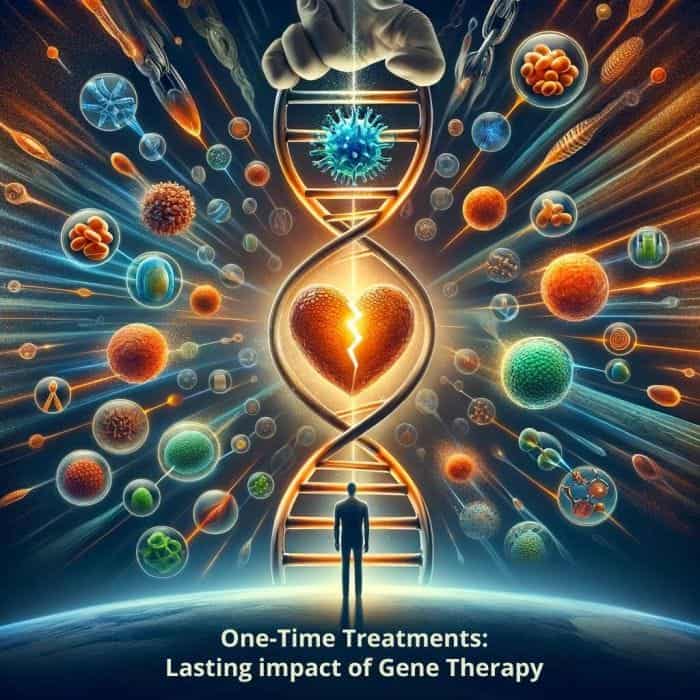
Gene therapy offers the revolutionary potential for one-time treatments that provide lasting effects, distinguishing it from traditional therapies that often require ongoing administration.
- This transformative approach can permanently correct the underlying genetic defect responsible for a disease, leading to sustained therapeutic outcomes.
- For diseases caused by a single genetic mutation, such as certain types of hemophilia, inherited retinal diseases, and spinal muscular atrophy, gene therapy has demonstrated the ability to provide durable and, in some cases, lifelong benefits with a single intervention.
- This not only improves patients’ quality of life by freeing them from the burdens of continuous treatment but also has the potential to significantly reduce long-term healthcare costs.
Scientific Anecdotes for References:
- Success in Hemophilia and Retinal Diseases: Recent clinical trials have shown remarkable successes in treating diseases like hemophilia and inherited retinal diseases using gene therapy, where a single administration has resulted in prolonged therapeutic effects. These advances highlight the potential of gene therapy to deliver long-lasting cures for diseases with known genetic causes, offering hope for conditions previously considered unmanageable or requiring lifelong treatment.
- Advancements in Delivery and Efficacy: The development of safer and more efficient gene delivery systems, such as adeno-associated viral vectors, has played a crucial role in the success of gene therapy as a one-time treatment. These vectors can target specific cells and deliver therapeutic genes with minimal side effects, leading to sustained therapeutic protein expression. This progress underscores the evolving capability of gene therapy to provide lasting benefits from a single treatment session.
13. Potential Cost Savings
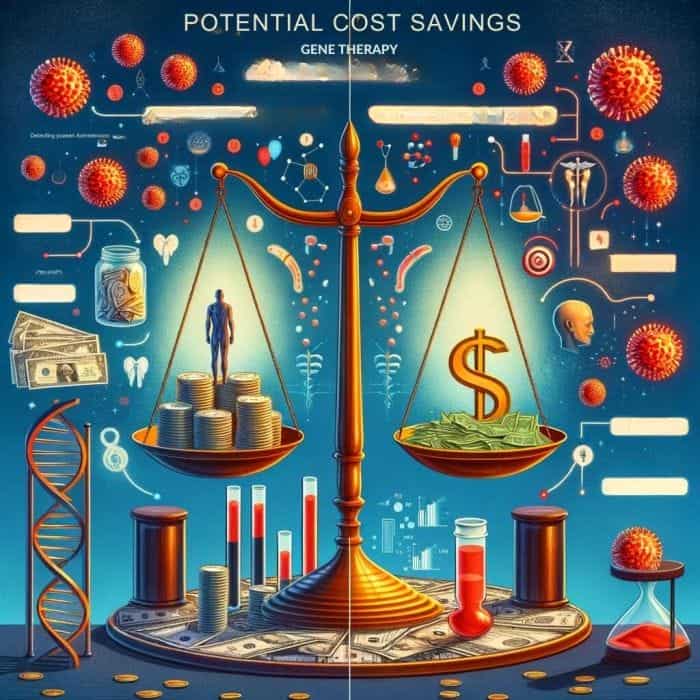
While often discussed in the context of its high initial costs, gene therapy also presents a significant opportunity for long-term cost savings within healthcare systems.
- By providing a one-time treatment that can potentially cure patients with chronic or life-threatening genetic diseases, gene therapy could significantly reduce or eliminate the need for lifelong medication, frequent hospital visits, and ongoing treatment interventions.
- This shift from chronic management to potential cures can lead to substantial savings over a patient’s lifetime.
- The cost-effectiveness of gene therapy becomes even more apparent when considering diseases that currently require expensive, lifelong treatments, such as hemophilia, where gene therapy can offer a phenotypic cure, drastically reducing the lifetime cost of care.
Scientific Anecdotes for References:
- Gene Therapy for Hemophilia: A cost-effectiveness analysis comparing gene therapy to traditional prophylaxis for severe hemophilia A demonstrated that gene therapy could lead to significant savings. Despite its high upfront cost, gene therapy resulted in a lower total cost over a patient’s lifetime due to the reduced need for ongoing factor VIII replacement therapyWhat is factor VIII replacement therapy?Factor VIII replacement therapy is a treatment for Hemophilia A, a bleeding disorder caused by a deficiency of clotting factor VIII. The therapy involves the regular infusion of factor VIII concentrates into the bloodstream to restore the blood's clotting ability, preventing and controlling bleeding episodes., which is both costly and burdensome. This study highlights gene therapy’s potential to offer both clinical and economic benefits by transforming a chronic disease into a manageable condition with a one-time treatment.
- Financial Impact of Gene Therapies: Another study assessing the financial impact of future gene therapies across a range of diseases estimated that while the peak annual spending on these therapies could be significant, the overall financial impact on healthcare systems might be manageable. This research suggests that the long-term benefits and potential cost savings of gene therapies, compared to the cumulative costs of existing treatments over time, could justify their high initial prices. The study also emphasizes the importance of innovative payment models to facilitate access to these transformative treatments).
14. Ethical and Social Benefits
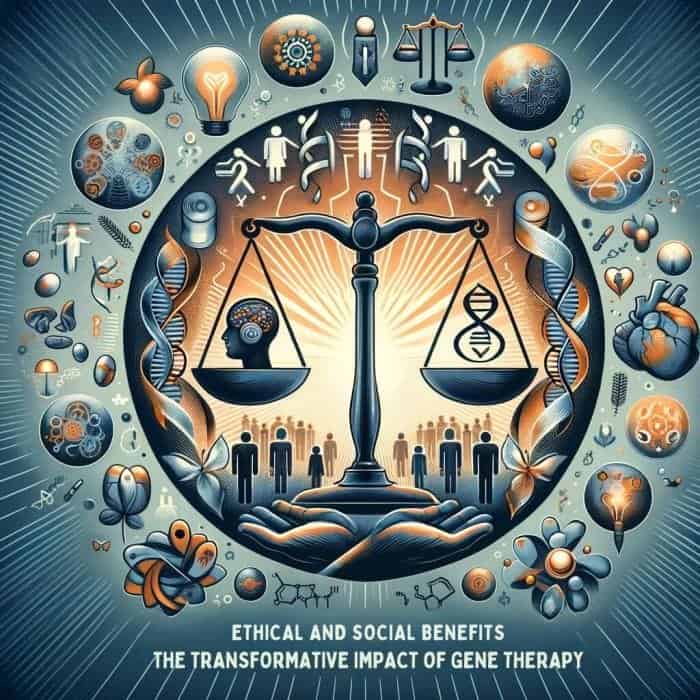
Gene therapy offers a significant ethical and social upside by potentially addressing diseases that have long been considered untreatable, thus reshaping our understanding of medicine’s limitations.
- This transformative approach promises to cure genetic disorders, reduce the burden of chronic diseases, and even prevent hereditary diseases from being passed on to future generations.
- Ethically, gene therapy challenges us to reconsider our approach to treatment, moving from managing symptoms to targeting the root cause of diseases at the genetic level.
- Socially, it presents an opportunity to alleviate the long-term suffering of patients and their families, reduce the stigma associated with certain genetic disorders, and potentially decrease healthcare costs over time by offering cures rather than ongoing treatments.
Scientific Anecdotes for References:
- Gene therapy’s ethical and social implications have been a topic of significant discussion within the scientific and medical communities. As gene therapy technologies, such as CRISPR/Cas9, advance, they offer the potential to cure diseases and raise important ethical questions about modifying human genetics. These discussions are crucial for guiding gene therapy’s responsible development and application, ensuring that it benefits humanity while respecting individual rights and societal values.
- Social media and public forums have emerged as valuable platforms for understanding public perceptions and ethical concerns related to gene therapy. Studies utilizing these platforms have revealed a broad spectrum of public opinions, from high hopes for treating untreatable diseases to concerns about genetic modification’s risks and ethical implications. This feedback is essential for addressing the public’s expectations and fears and for shaping policies that govern the development and implementation of gene therapy.
15. Innovation and Economic Growth

Gene therapy is a frontier of medical science and a catalyst for innovation and economic growth.
- The development and commercialization of gene therapy technologies have led to the establishment of numerous biotech companies, spurred investment in research and development, and generated high-skilled jobs in the Biotechnology and pharmaceutical sectors.
- Furthermore, the potential of gene therapy to provide one-time treatments for chronic diseases could revolutionize healthcare delivery, potentially reducing long-term healthcare costs and improving productivity by alleviating the burden of chronic illness.
- As gene therapy moves from experimental treatments to approved therapies, it contributes to the growth of a new sector within the healthcare industry, driving economic development and fostering innovation in related fields.
Scientific Anecdotes for References:
- Commercial Success and Challenges: Approving several gene therapy products marks a significant milestone in transitioning from research to clinical application. These successes reflect overcoming technical hurdles and underscore the economic potential of gene therapy. However, manufacturing capacity and market sustainability challenges highlight the need for continued innovation and investment. Addressing these challenges will be crucial for realizing gene therapy’s full economic and therapeutic potential.
- Economic Impact and Future Prospects: The gene therapy industry’s growth reflects the broader economic benefits of innovation in healthcare. By providing new treatments for untreatable diseases, gene therapy has the potential to significantly impact public health and economic productivity. Moreover, advancements in gene editing and delivery technologies promise to expand the range of treatable diseases, further contributing to economic growth and healthcare innovation.
16. Global Health Impact
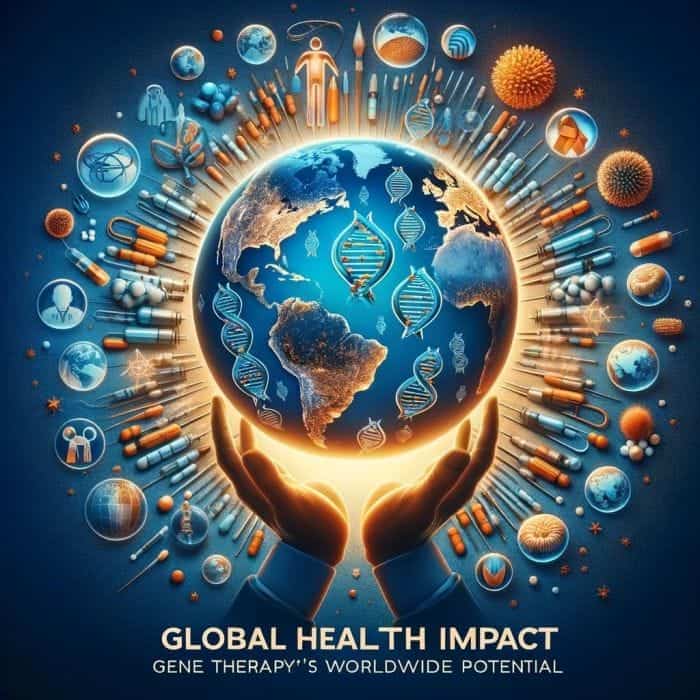
Gene therapy presents a significant potential to impact global health positively by offering treatments for a wide range of diseases, including those prevalent in low- and middle-income countries.
- The ability to address genetic disorders, infectious diseases, and cancers through gene therapy can substantially improve health outcomes worldwide.
- Moreover, the development of gene therapies for diseases such as HIV/AIDS, malaria, and tuberculosis could revolutionize the approach to these endemic conditions, potentially reducing their incidence and mortality rates significantly.
- The global application of gene therapy also highlights the importance of ethical considerations, accessibility, and affordability, ensuring that advancements in gene therapy benefit all populations, regardless of geographic location or economic status.
Scientific Anecdotes for References:
- Gene Therapy’s Broad Applications: Approving gene therapy products for various diseases marks a significant advancement in medical science, offering new treatment options for diseases that are challenging to manage with traditional therapies. This includes inherited immune disorders, hemophilia, eye and neurodegenerative disorders, and cancers. The broad applicability of gene therapy underscores its potential to substantially impact global health, providing durable benefits to human health across diverse populations.
- Challenges and Future Prospects: While gene therapy offers promising prospects for global health, several challenges remain, including understanding and preventing genotoxicity, improving gene transfer efficiency, preventing immune responses, and overcoming manufacturing and regulatory hurdles. Importantly, a societal consensus on the ethics of gene therapy, especially concerning germline editing, is crucial as the field advances. Addressing these challenges is essential for the successful and equitable deployment of gene therapy technologies worldwide.
Cons of Gene Therapy
Let’s focus on the cons of the Gene Therapy.
1. Serious Ethical Concerns
Ethical concerns surrounding gene therapy are complex and multifaceted, encompassing issues related to genetic modification, consent, and the potential for unforeseen consequences.
- These concerns are particularly pronounced when considering germline editing, which has the potential to alter the genetic makeup of future generations in unpredictable ways.
- The possibility of gene therapy leading to unintended genetic changes raises profound ethical questions about the extent to which humans should intervene in the natural genetic code.
Scientific Anecdotes for References:
- A study exploring public perceptions revealed that while there is high acceptance of gene therapy for treating severe illnesses, ethical concerns persist, particularly regarding treatments perceived as less necessary or for enhancement purposes. The public highlighted the fear of insufficient information and the potential for unforeseen consequences as major ethical concerns.
- Ethical discussions have emphasized the need for rigorous ethical frameworks to guide gene therapy, especially concerning germline modifications. The potential risks, misuse of technology, and concerns about fairness and the sanctity of life are central to the ethical debate surrounding gene therapy.
2. Religious Concerns
Gene therapy also intersects with various religious beliefs and doctrines, particularly regarding the modification of human genetics.
- Different religions have differing views on the acceptability of genetic interventions, with some viewing it as playing God or interfering with the natural order established by a higher power.
- These religious concerns can influence individuals’ decisions about receiving gene therapy and contribute to broader societal debates about the moral implications of genetic modification.
Scientific Anecdotes for References:
- The ethical and social implications of gene therapy have sparked significant debate within religious communities. Concerns revolve around the sanctity of human life, the natural order, and the moral limits of scientific intervention. The diversity of religious beliefs on gene therapy underscores the need for inclusive dialogue that respects various perspectives.
- Social media analysis of public opinions about gene therapy revealed a wide range of beliefs, including religious perspectives, on the ethical acceptability of gene therapy. These studies highlight the importance of considering religious concerns in the development and application of gene therapy, ensuring that treatments align with diverse moral and ethical values.
3. Ineffective Approach to Medical Science
Criticism of gene therapy as an ineffective approach center on its current limitations in achieving consistent and universally successful outcomes across all targeted diseases.
- While remarkable progress has been made in certain areas, such as specific genetic disorders and cancers, the effectiveness of gene therapy remains variable.
- Challenges include the complexity of gene regulation, variability in patient responses, and difficulties in targeting the right cells without affecting others.
- These issues underscore the need for further research and development to enhance gene therapy’s efficacy, precision, and safety as a medical treatment.
Scientific Anecdotes for References:
- Despite advancements, gene therapy faces challenges in clinical application, including non-specific expression, low-efficiency delivery, and biosafety concerns. Innovative strategies are developing to overcome these hurdles, aiming to make gene therapy a more effective and widespread treatment option for cancer and other diseases.
- Gene therapy has shown potential in treating neurodegenerative diseases. Yet, early clinical trials have not consistently demonstrated improvements beyond placebo effects. Efforts to enhance efficacy focus on vector design, delivery methods, and identifying new therapeutic targets.
4. Might Not Be Long-Term Effective
Concerns about the long-term effectiveness of gene therapy stem from uncertainties regarding the durability of therapeutic benefits.
- In some cases, the expression of the introduced gene may diminish over time, or the body’s immune response may negate the therapy’s effects.
- Additionally, for some genetic diseases, the complexity of gene interactions and disease progression over time may limit the lasting impact of therapy.
- These considerations highlight the importance of long-term studies to understand the durability of gene therapy and the need for potential re-treatment or ongoing management.
Scientific Anecdotes for References:
- The success of gene therapy in early clinical trials, particularly for treating blindness, neuromuscular disease, and hemophilia, has been encouraging. However, the long-term efficacy and safety of these treatments remain areas of active research, with ongoing efforts to understand and mitigate potential risks and improve the durability of therapeutic effects.
- Addressing the “dark matter” of gene therapy includes overcoming technical and ethical barriers to ensure the safe and effective long-term application of gene therapy. Challenges such as genotoxicity, efficiency, immune response, and ethical considerations remain critical for gene therapies’ widespread clinical application and long-term success.
5. Expensive Option
Gene therapy is heralded for its potential to cure diseases with a single treatment. Still, its high cost poses a significant barrier to widespread access.
- The price tags for gene therapies can reach several million dollars per treatment, making them some of the most expensive medical interventions available.
- These costs reflect the complex and resource-intensive processes in developing, manufacturing, and delivering gene therapies.
- While gene therapy offers transformative potential for patients with rare and untreatable conditions, the financial implications challenge healthcare systems and raise questions about affordability and equity in access to these innovative treatments.
Scientific Anecdotes for References:
- Gene therapies’ challenge as super-high-cost treatments are discussed in the context of their profound positive impact on patients’ lives versus the cost and uncertain funding mechanisms that present potential barriers to patient access. Innovative payment models are suggested to allow for sustainable reimbursement of these technologies.
- The debate on the high cost of gene therapy, especially for treatments like onasemnogene abeparvovec for spinal muscular atrophy, highlights important methodological and policy issues regarding the valuation of high-cost treatments. A detailed examination of other high-cost therapies suggests that while gene therapies are expensive upfront, their long-term cost-effectiveness compared to lifelong treatments needs careful consideration.
6. Currently Unreliable Delivery Method
One of the significant challenges facing gene therapy is the reliability of its delivery methods.
- Effective and safe delivery of therapeutic genes to the target cells without triggering adverse immune responses or affecting non-target cells remains a complex hurdle.
- While efficient in gene delivery, viral vectors can pose safety risks, including immunogenicity and potential insertional mutagenesis.
- Non-viral delivery methods offer a safer alternative but often suffer from lower efficiency and transient expression.
- The ongoing development of safer and more reliable delivery systems is crucial for the future success of gene therapy.
Scientific Anecdotes for References:
- The development of safe and efficient gene delivery vehicles is crucial for the success of gene therapy, with viral vehicles offering high efficiency but potential safety risks and non-viral carriers offering safer but less efficient alternatives. The search for safer and cheaper delivery methods is ongoing.
- Addressing gene therapy’s “dark matter” involves overcoming barriers to its safe and effective application, including the reliability of the delivery method. Challenges such as genotoxicity, immune response, and ethical considerations are critical for the widespread clinical application of gene therapies.
7. Uninsured Results
A significant concern with gene therapy is the unpredictability and variability of outcomes, which can lead to uninsured or non-guaranteed results.
- Despite promising clinical trials, not all treatments have consistently achieved long-term success across all patients.
- This variability challenges insurance coverage and patient access, as insurers may hesitate to cover treatments without established, consistent outcomes.
- The issue of uninsured results highlights the need for further research to understand the factors that influence gene therapy’s effectiveness and develop strategies to enhance its reliability and predictability.
Scientific Anecdotes for References:
- Gene therapy’s journey from concept to clinical application has been marked by significant achievements and challenges. Recent clinical successes have showcased the potential for durable benefits. Still, the variability in patient responses necessitates a deeper understanding of gene therapy’s mechanisms to ensure consistent and predictable outcomes.
- The development of gene therapies has faced setbacks due to therapy-related toxicities in early trials. These challenges have fueled research into safer and more effective gene transfer vectors, highlighting the need for ongoing innovation to overcome the unpredictability of results.
8. May Encourage Gene Doping
As gene therapy technologies advance, there is growing concern over the potential misuse of these treatments in the form of gene doping.
- This unethical practice involves modifying genes to enhance athletic performance, posing significant ethical and health risks.
- The possibility of gene doping undermines the spirit of fair competition in sports. It raises concerns about the safety of unregulated gene modifications.
- The potential for gene doping highlights the need for strict regulations and monitoring to prevent the misuse of gene therapy technologies for performance enhancement.
Scientific Anecdotes for References:
- The ethical and societal implications of gene therapy extend beyond medical treatment, raising concerns about the potential for misuse in enhancing athletic performance. The development of regulatory frameworks is crucial to ensure that gene therapy technologies are used responsibly and ethically.
- Discussions on the ethics of gene therapy have emphasized the importance of addressing the potential for gene doping, highlighting the need for international cooperation and regulatory measures to prevent the misuse of gene editing technologies for performance enhancement.
9. Can Provide Unintended Side-Effects
Gene therapy, while offering groundbreaking therapeutic potential, can also lead to unintended side effects, some of which may be serious.
- Early clinical studies encountered serious adverse effects, including inflammatory responses to vectors and malignancies caused by vector-mediated insertional activation of proto-oncogenesWhat is proto-oncogenes?Proto-oncogenes are normal genes that play a crucial role in cell growth, differentiation, and division. When mutated or expressed at high levels, they can become oncogenes, driving the development of cancer by promoting uncontrolled cell proliferation..
- These setbacks have underscored the importance of understanding the complex interactions between therapeutic genes, vectors, and the host’s biology to minimize risks.
- Despite advancements in vector designs and gene-editing technologies, the potential for off-target effects, immune reactions, and other unintended consequences remains a concern that requires ongoing vigilance and research.
Scientific Anecdotes for References:
- The journey of gene therapy has been marked by both clinical benefits and challenges, such as therapy-related toxicities. Advances in vector technology and gene editing have improved safety. Still, the risk of unintended side effects remains a significant concern. This highlights the need for continued research into safer delivery mechanisms and therapeutic strategies.
- The path from concept to clinical application of gene therapy has involved overcoming setbacks, including therapy-related toxicities. These experiences have fueled research leading to safer and more efficient gene transfer vectors, emphasizing the importance of mitigating unintended side effects for the future success of gene therapy.
10. Invasion of Privacy
The application of gene therapy, particularly in the context of Genetic Testing and modification, raises concerns about privacy and the potential misuse of genetic information.
- The collection, storage, and use of genetic data pose risks to individual privacy, with implications for insurance coverage, Employment, and social stigma.
- Ensuring the confidentiality and ethical use of genetic information is paramount to prevent discrimination and protect individuals’ rights.
- The debate over privacy concerns in gene therapy reflects broader issues related to the sensitivity of genetic data and the need for robust safeguards to protect individuals in the era of genomic medicine.
Scientific Anecdotes for References:
- Concerns about privacy and the ethical use of genetic information have been highlighted in discussions on gene therapy. The need for strict regulatory frameworks and protections to safeguard individual privacy and prevent misuse of genetic data is critical as gene therapy and related genetic technologies advance.
- The ethical and societal implications of gene therapy extend to concerns about privacy and the potential for genetic discrimination. Addressing these concerns requires comprehensive policies and regulations to ensure that advances in gene therapy benefit patients without compromising their privacy or rights.
11. Limited Accessibility
Gene therapy’s potential is vast, yet its accessibility remains limited, primarily due to high costs, complex delivery mechanisms, and the need for specialized treatment centers.
- This limitation is particularly pronounced in lowand middle-income countries, where healthcare infrastructure may not support the advanced requirements of gene therapy treatments.
- Additionally, even in developed countries, the high cost of these therapies may make them inaccessible to a significant portion of the population, raising concerns about equity in healthcare.
- The challenge of making gene therapy widely accessible underscores the need for global collaboration in research, pricing strategies, and healthcare policies to ensure that the benefits of these innovative treatments can be shared more broadly.
Scientific Anecdotes for References:
- Gene therapy’s promise of delivering ‘cures’ for severe conditions is tempered by challenges in safe delivery and the need for improved vector designs. Despite clinical successes, the broader application and accessibility of gene therapy are hindered by these technical and infrastructural challenges.
- Developing non-viral vectors for gene-based therapy highlights progress in addressing delivery challenges. Yet, accessibility remains limited due to the high cost and complex infrastructure required for treatment. Material sciences and nanotechnology advances offer hope for more accessible solutions, but significant barriers to widespread application persist.
12. Regulatory Hurdles
The path to bringing gene therapies to market involves navigating complex regulatory landscapes, which can vary significantly across different jurisdictions.
- These regulatory hurdles are necessary to ensure the safety and efficacy of treatments. Still, they can also slow the development and approval process.
- For new gene therapies, demonstrating long-term safety and therapeutic benefits to meet regulatory standards requires extensive, time-consuming, and costly clinical trials.
- The challenge of meeting these regulatory requirements can delay access to potentially life-saving treatments for patients and add to the overall cost and complexity of developing gene therapies.
Scientific Anecdotes for References:
- The journey of gene therapy from concept to clinical application highlights the challenges posed by therapy-related toxicities and the regulatory barriers these issues have created. While regulatory bodies have a critical role in ensuring patient safety, the complexity of meeting these standards can impede the progress of new therapies.
- Developing safer gene delivery systems, such as non-viral vectors, represents progress in addressing safety concerns. However, the regulatory environment remains a significant hurdle, with a need for frameworks that can adapt to the rapid advancements in gene therapy technologies while ensuring patient safety.
13. Technical Challenges
Gene therapy faces numerous technical challenges that can hinder its effectiveness and application.
- These include the complexity of delivering therapeutic genes to specific target cells without affecting non-target cells, avoiding Immune System reactions that can neutralize therapeutic vectors, and ensuring long-term expression of the introduced genes.
- Additionally, the potential for off-target effects, where gene editing tools might inadvertently alter genes other than those intended, raises safety concerns.
- Addressing these technical challenges is crucial for advancing gene therapy from experimental treatments to widely available clinical solutions.
Scientific Anecdotes for References:
- Gene therapy’s potential to treat sickle-cell diseaseWhat is sickle-cell disease?Sickle-cell disease is a genetic blood disorder characterized by the production of abnormal hemoglobin, leading to red blood cells that are rigid, sticky, and shaped like sickles or crescent moons. These misshapen cells can block blood flow, causing pain, infections, chronic anemia, and damage to organs. underscores its promise and the remaining technical hurdles. Challenges include ensuring safe and targeted delivery, overcoming immune responses, and achieving durable therapeutic effects.
- Gene therapy has seen significant advancements and challenges, including developing delivery vectors, targeting precision, and managing patient immune responses. These ongoing challenges highlight the complexity of translating gene therapy into successful clinical applications.
14. Psychological Impact
The decision to undergo gene therapy, especially for hereditary diseases, carries psychological impacts on patients and their families.
- Concerns about the long-term effects, potential risks, and ethical implications of altering one’s genetic makeup can lead to anxiety and ethical dilemmas.
- Furthermore, the prospect of germline editing, which could affect future generations, adds another layer of psychological consideration.
- Addressing these concerns requires comprehensive counseling and ethical deliberation to support patients and families through decision-making.
Scientific Anecdotes for References:
- The transition of gene therapy from concept to clinical application has been fraught with both technical challenges and ethical controversies, including concerns about therapy-related toxicities and the psychological impact on patients. These experiences have emphasized the need for careful ethical consideration and patient support.
- Ethical considerations surrounding gene therapy, especially germline modifications, have sparked debate and concern. Addressing these ethical and psychological impacts requires ongoing dialogue and ethical frameworks to guide the responsible development and application of gene therapy.
15. Environmental Concerns
Gene therapy, particularly involving genetically modified organisms (GMOs), raises environmental concerns about potential unintended ecological impacts.
- The release of GMOs into the environment, whether accidentally or as part of a treatment strategy, could potentially affect non-target organisms and biodiversity.
- Concerns include the horizontal transfer of inserted genes to other organisms, which could lead to unforeseen ecological consequences.
- Addressing these concerns requires thorough environmental risk assessments before gene therapy products’ clinical or environmental release and ongoing monitoring to understand the long-term ecological impacts.
Scientific Anecdotes for References:
- The rapid development of gene therapy technologies, including those involving genetically modified organisms, necessitates a thorough understanding of the potential environmental impacts. The field of gene therapy is challenged to balance therapeutic innovation with the responsible stewardship of environmental health.
- Environmental risk assessment of advanced therapies containing genetically modified organisms emphasizes the importance of evaluating the potential environmental impacts of gene therapy products. A streamlined process for assessing these risks aims to facilitate a consistent approach, highlighting the need for caution and regulatory oversight in developing and applying gene therapies.
16. Insurance Coverage and Cost-effectiveness
The high cost of gene therapy treatments raises concerns about insurance coverage and cost-effectiveness.
- Insurance companies may be reluctant to cover these expensive treatments, particularly if long-term efficacy and cost-benefit analyses are not clearly established.
- This situation poses a significant barrier to access for many patients, potentially limiting the reach of gene therapy to only those who can afford it out-of-pocket.
- Developing strategies to demonstrate the cost-effectiveness of gene therapies and negotiating coverage with insurers are critical steps in ensuring broader patient access to these potentially life-saving treatments.
Scientific Anecdotes for References:
- The discussion on the cost of gene therapy treatments and their coverage by insurance companies underscores the need for innovative payment models and cost-effectiveness studies. Addressing these issues is crucial for making gene therapies accessible to a wider population.
- Evaluating the financial impact of future gene therapies highlights methodological and policy challenges in assessing the value of these high-cost treatments. Comprehensive cost-benefit analyses are essential for demonstrating the long-term value of gene therapies and securing insurance coverage.
17. Dependency on Technological Advancements
The progress and effectiveness of gene therapy are heavily reliant on ongoing technological advancements.
- Innovations in gene editing, vector design, and delivery mechanisms are crucial for improving gene therapies’ safety, efficacy, and applicability.
- While these advancements have driven significant progress in the field, they underscore gene therapy’s dependency on cutting-edge research and development.
- This reliance means that setbacks in technology or scientific understanding can directly impact the feasibility and effectiveness of gene therapy treatments, posing challenges for consistent clinical application and accessibility.
Scientific Anecdotes for References:
- Major advancements in targeted gene therapy for neurological disorders highlight the field’s reliance on technological innovations for therapeutic success. Recent developments in viral vector designs, nanoparticle delivery, and CRISPR-based therapeutics have expanded treatment possibilities for diseases like Parkinson’s and Alzheimer’s. However, these advancements also reflect the dependency of gene therapy’s potential on the continuous evolution of technology.
- The journey of gene therapy from concept to clinical reality underscores the critical role of technological innovations in overcoming early clinical setbacks and achieving therapeutic benefits. Developing safer vector designs and gene editing tools has been key to recent successes. However, the field’s progress remains intertwined with the advancements and availability of these technologies.
18. Technical and Ethical Barriers
Beyond the technical challenges of developing safe and effective gene therapies, the field also navigates complex ethical barriers.
- These include concerns about germline editing, potential unintended consequences, and equitable access to therapies.
- The dependency on advanced technologies requires significant investment in research and development and ethical deliberation and policy-making to ensure that gene therapies are developed and applied in a manner that is safe, effective, and accessible to all who might benefit from them.
Scientific Anecdotes for References:
- Advances in gene therapy technologies, including CRISPR/Cas9 and RNA interference, offer promising treatment avenues but raise ethical and societal concerns that must be addressed. Integrating ethical considerations into the development and deployment of gene therapy is essential for its responsible advancement.
- The evolution of gene therapy has been accompanied by significant ethical, regulatory, and technical challenges. Addressing these barriers is crucial for the field’s progress and ensuring that gene therapies can be safely and effectively applied to treat a wide range of diseases.
Cite This Page
At the end of the day, gene therapy is only applicable and useful if it is perfected. Without jumping the snags of all listed cons, gene therapy will not be as valuable as it can be.
It is the only ray of light for those who are suffering from the disease having no cure at all with medications except alternation of genes. And in this time of problems with which mankind is experiencing, this little hope should not get escaped.
All ethical and religious concerns should be reasoned with logical arguments as well as insurance to no gene doping should be made sure. Only then this method will be fruitful for all.





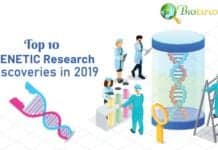














[…] https://www.bioexplorer.net/gene-therapy-pros-cons.html/ […]